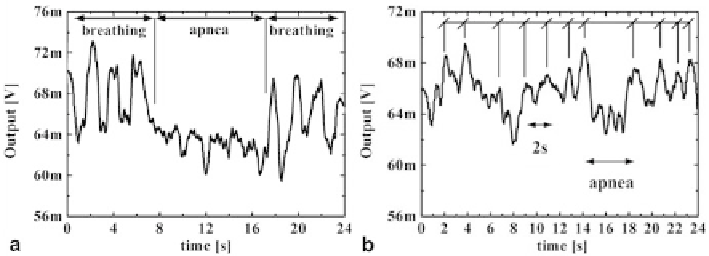Biomedical Engineering Reference
In-Depth Information
Fig. 15 a
Output voltage (measured) in tracking mode (TM) (
f
PR
=
40 MHz) for the case of an
adult person under test (see Fig.
14
a). In the first phase of the experiment the person under test is
breathing; in the second phase the person under test is holding the breath voluntarily; in the third
phase the normal respiration process is restored.
b
Output voltage (measured) in TM (
f
PR
=
40
MHz) in the case of a baby under test (see Fig.
14
b). The respiratory rate is slightly irregular with
an average of 0.5 Hz. Note that the radar detects very short apneas of 3 s
Conclusions
In this chapter, we have introduced the technology and application of UWB radar
sensor for the contactless detection of respiratory rate. In particular, we have re-
ported the key aspects and the main results of the on-going research carried out by
our group. In detail, we have shown an ultra wideband (UWB) radar sensor for respi-
ratory rate monitoring designed and implemented by integrating a SoC UWB radar
realized in 90 nm CMOS technology with a board with two planar antennas, one for
the transmitter and one for the receiver. The radar test-chip, packaged in QFN32,
was attached to the board and the planar antennas and codesigned accordingly, so
achieving a working UWB sensor prototype compliant with the FCC UWB standard
regulations, in particular for medical applications.
The operation of the radar sensor was proven by means of functional and field
operational tests. The radar was able to track reflective targets for movements (front-
back) up to 2 cm around a distance of 70 cm. The UWB sensor was applied to the field
operational tests on adult (both gender) and infant volunteers placed at a distance up
to 45 cm. The results show that the radar sensor allows the detection of subcentime-
ter chest movements, allowing the continuous-time monitoring of respiratory rate
associated with the normal activity, including apneas.
This UWB sensor could be potentially employed in a number of biomedical appli-
cations, such as monitoring babies in cot beds, patients in hospitals, and other people
at risk of obstructive apneas. It can be also used for the early detection of sudden
sleep of drivers in vehicles. This contactless sensing technology enables also other
important applications such as fitness monitoring and personalized healthcare for in-
dependent and healthy living. Despite all its potential applications in the biomedical
field, it can be also applied to a large number of other civil applications demanding
contactless detection of moving objects nontransparent to UWB radiation, opening
new and interesting chapters of the long and successful story of the radar technology.

Search WWH ::

Custom Search